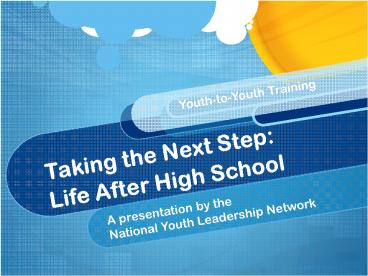Taking the Next Step: Life After High School PowerPoint PPT Presentation
1 / 11
Title: Taking the Next Step: Life After High School
1
Taking the Next Step Life After High School
Youth-to-Youth Training
- A presentation by the
- National Youth Leadership Network
2
What is NYLN?
- A youth-led, youth-run national organization that
serves as a voice for and network of young
leaders with disabilities. - Our members are youth and young adults with
disabilities (age 16-28) and allies (siblings,
friends, parents, teachers, etc.). - You can register to be an NYLN member at
www.nyln.org. As a member you will get great info
and be connected to other young leaders and
allies around the country.
IMAGE Picture of the NYLN logo. It has a hand
imprint on it, and it reads National Youth
Leadership Network.
3
Life After High School
- Thinking about what to do after high school can
be scary, but your teachers, school counselors,
vocational rehabilitation counselors, family, and
friends are all there to help. - You have many options after high school. You
could enter an apprenticeship, get a job, go to
college, or go to a technical school or trade
school.
IMAGE Graduation caps in the air.
4
Preparing for College
- You need the following to apply to college
- A completed application to the college
- Your high school transcript
- The results from the ACT or SAT standardized
tests - Letters of recommendation from people who are not
family members - You can ask for accommodations on the SAT and ACT
tests. This may include extended time or taking
the test in a different room. - For a fee, you can also take private classes
offered by companies to improve your score on the
SAT or ACT. You can buy books or borrow them (for
free) from the library. These books will give
you practice questions and study tips to get
ready for the tests.
IMAGE A guy holding a paper from school and
smiling.
5
Trade/Technical School
- A trade/technical school is a school where you
can go to learn a special skill. - You can learn things like welding, mechanics,
cosmetology (hair and make-up), or computer
technology. - Trade schools are all over the country. You can
talk to you high school counselor to find out
options for trade schools or go online to find a
list of schools.
IMAGE A teacher is showing a student at a
technical school how to build something.
6
Entering the Workforce
- Going to college is a great idea for some, but it
isnt your only option. - You can enter the workforce or get an
apprenticeship, a work experience either paid or
unpaid that allows you to gain skills while
actually doing a job. - You can write job goals into your IEP in high
school, if you plan to go directly into the
workforce. - Your school counselor or vocational
rehabilitation (VR) counselor can help you plan
ahead and learn the skills you need to get a job. - Set long-term career goals for yourself. Use any
jobs you can get as starting points for where you
want to go.
7
Paying for Your Education
- Many students worry about how they will pay for
college or technical school. - There are many ways to get financial help.
- Financial aid through your college
- Scholarships through your community
- Federal loans (apply using a form called FAFSA)
- Private loans through local banks
- On-campus jobs
IMAGE A little character looks worried and has
money signs above his head.
8
Financial Aid
IMAGE Stacks of money.
- Financial aid is money that helps you pay for
school. You can get scholarships, private loans,
government loans, and grants. - Almost all colleges and technical schools have a
Financial Aid Office. If you need any help, just
ask the people who work in that office. Your high
school guidance counselor might know about
financial aid options as well.
9
Scholarships
IMAGE Someone is filling out a scholarship
application.
- A scholarship is money that you apply for. Many
people usually compete for scholarships. It is
awarded to you to help you pay for school. - There are many types of scholarships. Some give
money based on good grades and some are for
athletes. Some are just for people of a certain
cultural background or ethnicity. - Talk to your financial aid office, your high
school counselor, or use the Internet to find
different scholarships.
10
Transition from IDEA to ADA
IMAGE A dictionary definition of legal.
- In high school you have an Individualized
Education Plan (IEP). You get an IEP because of
the Individuals with Disabilities Education Act
(IDEA). An IEP explains your goals for that
school year and the accommodations you need so
you can accomplish them. IEPs also give you a
transition plan for going to work or college
after you graduate. - In college the IEP is gone. The Americans with
Disabilities Act (ADA) now applies. This law
says that students with disabilities have the
right to an equal education and reasonable
accommodations at college. You need to ask for
accommodations yourself to get them. You are now
in charge of advocating for yourself.
11
For more information, or to become a member,
contact us National Youth Leadership Network
(NYLN) www.nyln.org 1-866-480-6565

